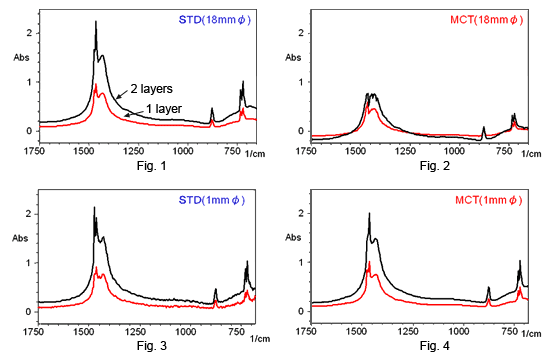Q: MCT detectors are said to be high-sensitivity detectors. In what circumstances are they needed?
A : Typical examples where MCT detectors are used are infrared microscope measurements, heated vacuum diffuse reflectance measurements, long-path gas cell measurements, and GC-FTIR measurements. The common feature of these measurements is that relatively weak light reaches the detector. In these cases, MCT detectors are remarkably effective compared to standard detectors. However, note that if the light is adequately strong, the high sensitivity of an MCT detector may conversely prevent an accurate spectrum from being obtained.
We compared the transmission spectra for white film using a 1-mm dia. mask and 18-mm dia. mask with both a standard detector and MCT detector. Fig. 1 to Fig. 4 show these results for both one layer and two layers of film (red: one layer; black: two layers) to check the peak linearity. Measurement conditions are 4 cm-1 resolution with 10 measurements.
Comparing the results for the 18-mm dia. mask, it is apparent that the MCT detector (Fig. 2) offers no linearity of peak intensity compared to the standard detector (Fig. 1). On the other hand, using a 1-mm dia. mask results in poor S/N ratio for the standard detector (Fig. 3), whereas the MCT detector maintains the linearity and achieves good S/N ratio.

From the results above, a low light level is a precondition for using the MCT detector. If the light is strong, an attenuator must be used to reduce the light intensity. In addition, consider the wavenumber range characteristics when selecting the detector.


